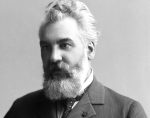The first practical telephone was patented by Alexander Graham Bell, a Scottish-born inventor, scientist, and engineer who lived from March 3, 1847, to August 2, 1922. In 1885, he also participated in founding the American Telephone and Telegraph Company (AT&T).
Bell's mother and wife were both deaf, which had a significant impact on his life's work. Bell's father, grandpa, and brother had all been involved with the study of elocution and speech. Bell continued to experiment with hearing aids as a result of his studies into speech and hearing, and on March 7, 1876, he was granted the first American patent for the telephone. Bell refused to install a telephone in his study because he saw his invention as a distraction from his actual work as a scientist.
Early Life
Bell was born on March 3, 1847, in Edinburgh, Scotland. A stone inscription identifying Bell's birthplace is located in the family's residence on South Charlotte Street. His two brothers, Melville James Bell (1845–1870) and Edward Charles Bell (1848–1867), both passed away from tuberculosis, were his siblings. His mother was Eliza Grace Bell (née Symonds), and his father was phonetician Alexander Melville Bell. Alexander Bell was given the name "Alexander Bell" at birth, but when he was 10 years old, he begged his father for a middle name like his two siblings. The name "Graham" was chosen in honor of Alexander Graham, a Canadian being treated by his father who had grown to be a family friend, and was approved by him father on his eleventh birthday.
The Telephone
Bell's early work on the harmonic telegraph had reached a formative stage by 1874, with significant advancements achieved both in his new Boston "laboratory" (a rented space) and at his family's house in Canada. Bell experimented with a "phonautograph" while working in Brantford that summer. This device resembled a pen and could trace the vibrations of sound waves to sketch the forms of those waves on smoked glass. Bell hypothesized that it could be feasible to produce wavy electrical currents that matched sound waves. Bell also believed that it would be possible to recreate sound using a harp's many metal reeds tuned to various frequencies. However, he lacked a working model to illustrate the viability of his concepts.
The Western Union president William Orton described telegraph message traffic in 1874 as having become "the nervous system of commerce" as it was growing quickly. In order to minimize the high cost of building additional lines, Orton had a contract with inventors Thomas Edison and Elisha Gray to devise a method of sending numerous telegraph messages on each telegraph line. When Thomas Sanders and Gardiner Hubbard learned that Bell was developing a way to communicate numerous tones on a telegraph cable using a multi-reed device, the two wealthy backers started to contribute money to his research. Anthony Pollok, Hubbard's patent attorney, would handle all patent-related matters.
Bell and Pollok met Joseph Henry, a physicist and then-director of the Smithsonian Institution, in March 1875 and sought Henry's opinion on the electrical multi-reed device that Bell anticipated would enable voice telegraphy. Bell had "the seed of a great invention," Henry retorted. Bell stated that he lacked the essential knowledge, to which Henry responded, "Get it!" Bell was tremendously inspired by that statement to continue trying despite the fact that he lacked the tools necessary to carry out his tests and the skills necessary to build a functional model of his theories. However, all changed in 1874 when Bell and Thomas A. Watson, a skilled electrical designer and technician working at Charles Williams' electrical machine company, met by coincidence.
Bell worked with Thomas Watson as his assistant, and the two of them conducted acoustic telegraphy experiments with the help of funding from Sanders and Hubbard. Bell, who was on the other end of the line when Watson mistakenly plucked one of the reeds on June 2, 1875, heard the overtones of the reed, which were essential for conveying voice. Bell was able to see that only one reed or armature was required, not several reeds. The "gallows" sound-powered telephone, which could only transmit muddled, voice-like sounds and not clear speech, was the result of this.

